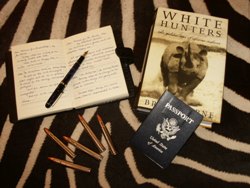

 The Accurate Reloading Forums
The Accurate Reloading Forums  THE ACCURATE RELOADING.COM FORUMS
THE ACCURATE RELOADING.COM FORUMS  Hunting
Hunting  Hunting Reports - Africa
Hunting Reports - Africa  Forest Duikers and Buff with Double in Coutada 10 with Marromeu Safaris
Forest Duikers and Buff with Double in Coutada 10 with Marromeu SafarisGo  | New  | Find  | Notify  | Tools  | Reply  |  |
| One of Us |
Forest Duikers and Buff with Double in Coutada 10 with Marromeu Safaris Location: Coutada 10, Northeastern Mozambique, Zambezi River Delta Outfitter: Marromeu Safaris PH: Anton Smit (Tom) Quenton (Ron) Morne (David) Albert (Ken) Steve Stanley (Mike) Dates: July 20-30, 2015 Rifles: Blaser R8/.375 H&H/Leupold VX-6 2-12x Ammo for .375: Softs – 300 gr. Barnes TSX Solids – 300 gr. North Fork Flat Point Solids & 300 gr. North Fork Cup Point Solids Merkel 140-2.1/.450-400 N.E. Ammo for .450-400: Softs – 400 gr. North Fork Semi-Spitzer Solids – 400 gr. North Fork Cup Point Solids Animals Taken: Tom: Buffalo, Blue Duiker, Red Duiker, Suni, Oribi, Chobe Bushbuck, Warthog & Baboon + Common Reedbuck & Warthog (bait) Ron: Buffalo, Chobe Bushbuck, Oribi, Reedbuck, Waterbuck, Roosevelt Sable, Warthog, Lichtenstein’s Hartebeeste David: Buffalo, Common Reedbuck, Roosevelt Sable, Warthog, Red Duiker, Bushpig, Nyala, Blue Duiker Mike: Chobe Bushbuck (bow), Warthog (bow), Roosevelt Sable (rifle), Warthog (rifle), Nyala (rifle), Waterbuck (bow) Ken: Buffalo, Waterbuck, Roosevelt Sable, Warthog Travel: Gracy Travel International – Atlanta to Joburg on Delta, overnight at the Intercontinental at Tambo, SAA to Beira, charter from Beira to camp. The “Amigos” are a group of five guys who first got together for a hunt at Estancia Poitahue in Argentina in 2012. Since that time we have enjoyed hunting together in South Africa, Tanzania and now Mozambique. We enjoy getting together annually for the Dallas Safari Club show and reviewing an annual video of our hunts. Camaraderie and humor are just as important to our group as taking quality animals. For 2015, we selected Coutada 10 in Mozambique as our hunt destination. We met with Anton Smit at DSC in 2014 to book and again in 2015 to fine tune our details. With the exception of Mike, who would be hunting with a bow and was not interested in buffalo, we each purchased a package that included coverage of the daily rate for a 10 day hunt and the trophy fee for a Cape Buffalo. The Trip to Mozambique With the exception of Ken, we are all veterans of African hunting and were familiar with the Delta flight to Joburg and overnighting there. The Delta flight was exactly as it has been every other time I’ve taken it – on-time and hassle free. The Delta ticket agent at O’Hare (my departure point) was unflustered by my rifles and I had no difficulty with TSA (they did not need to open my case to look at my rifles, either departing Chicago or on my return when I re-checked in Atlanta after clearing Customs). I used my Pelican case with a custom interior designed by Amigo Dave (who is in the business of selling such cases):  My rifles arrived in good shape with only one issue – I was unable to assemble my double rifle because the ejectors were preventing me from attaching the forend. One of the cameramen and one of the PHs worked together to sort that out and get my double assembled. We elected to stay at the Hotel Intercontinental at Tambo on this trip. I usually stay at the City Hotel, but some in our group prefer the Intercontinental. It is a cut above the City Hotel – the rooms are a little nicer and the restaurant and bar is nicer, but I was just as happy at City Hotel. I have also stayed at Africa Sky when transiting Joburg, and though I think the world of the accommodations there, you just can’t beat the convenience of the airport hotels. Bruce Mduli and Lucky from Gracy Travel were there to shepherd us safely through Tambo as usual. Those two guys are worth their weight in gold – no issues whatsoever with SAPS or getting re-checked for our flight to Beira the following morning. Sadly, no equivalent to Bruce and Lucky were available to us upon arrival in Beira. The process of getting the guns cleared into Mozambique was a pain, both on arrival and on departure. To begin, the police officers responsible for the process either did not speak English or were pretending not to speak English. They found an issue with the paperwork for nearly every one of us. In my case, the paperwork listed the caliber of my double rifle as “4450-400”. Because my rifle is chambered for .450-400 N.E., they claimed that I lacked the proper authorization to bring the rifle in. In addition, they claimed my paperwork said I was bringing only 70 rounds when in fact I had 120 (40 rounds for the double, 80 for the .375 (40 softs and 40 solids)). All my applications, etc. had specified 120 but the permit that actually got issued inexplicably said 70. One of the other Amigos goes by his middle name and uses an initial for his first name. Since the initial is on his passport but wasn’t on the gun permit, that was a problem. Others also had the same issue I had with regard to quantity of ammo. It was clear to us that this was simply an effort by the authorities to solicit bribes to fix our paperwork. We refused to pay any bribes and instead simply attempted to explain and argue our way through the process – eventually the authorities gave up trying to shake us down and let us leave with our rifles. We experienced a similar effort to shake us down on the exit from the country, with manufactured problems with the rifles and paperwork. In addition, my duffel bag arrived in Beira with all my TSA locks cut off and cinch straps unbuckled. It was clear that someone either at Tambo or at the airport in Beira had gone through the bag. Fortunately, nothing was taken – mainly because I put nothing of value in my checked luggage other than a Leatherman and GPS that are locked in my ammo box inside the duffle (and that box was intact and still locked). On departure from Beira, after checking my bags I was summoned back to the ticket counter from the airport lounge by half a dozen police officers. They accused me of “taking something from camp” and demanded that I open my duffel to let them inspect it. It occurred to me only afterward that: 1.) they wanted to watch me open my combination TSA locks so they would be able to re-open the bag later; and 2.) wanted to see if there was anything worth stealing in the bag. The police officer who conducted the search was very thorough, inspecting my shoes, my bathroom kit, and a first aid kit carefully. Eventually I was allowed to re-pack, close up and re-lock the bag. It arrived home with nothing missing (again, nothing worth taking in there other than the Leatherman and GPS in my ammo box). The 45 minute long charter flight was uneventful, and we arrived in camp in the late afternoon, hot and tired. We immediately sighted in our guns on a very nice range (nicest I’ve seen in any safari camp) with a covered shooting bench and permanent target boards 100 yards downrange with a backstop. The Camp Accommodations The camp was among the best I’ve stayed at in Africa on hunts conducted in government concessions (as opposed to private land). Apparently operators in Mozambique are given 15 year agreements to manage their concessions. They are permitted to put up permanent buildings, dig wells and otherwise improve their areas but may not remove or destroy any improvements when they leave if they do not renew. Marromeu’s camp consists of wooden “chalets” that are in the typical style of a Botswana tent with an en suite bathroom with flush toilet, running water, shower, etc. Hot water is available 24/7. 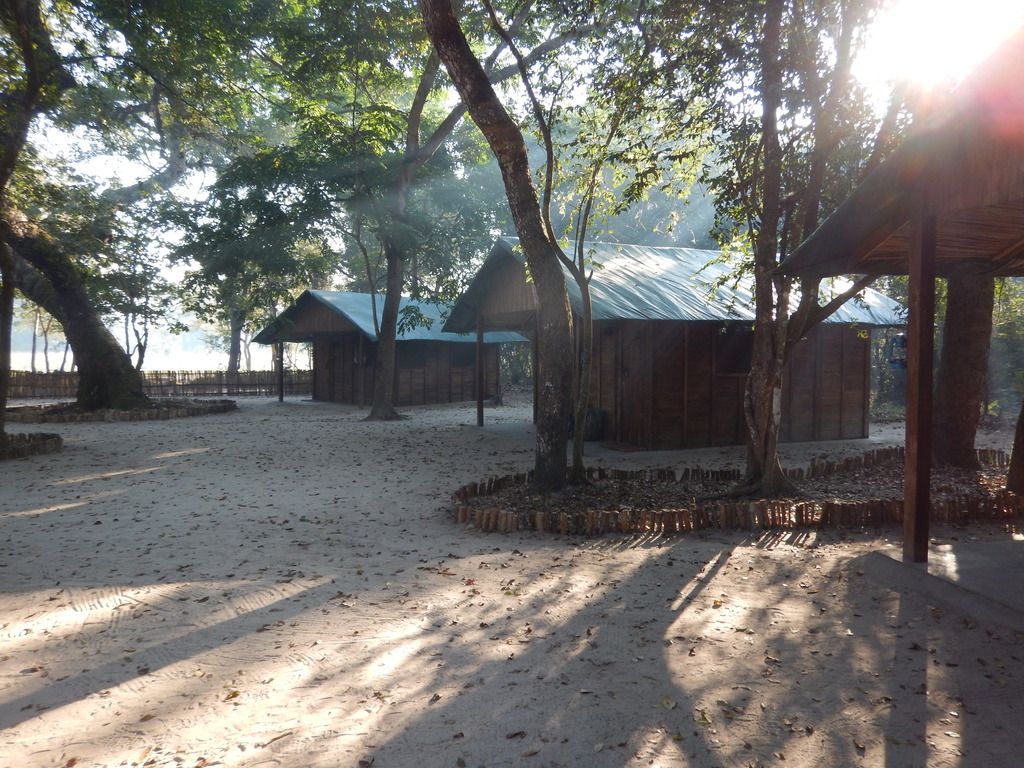 Permanent wooden chalets in camp 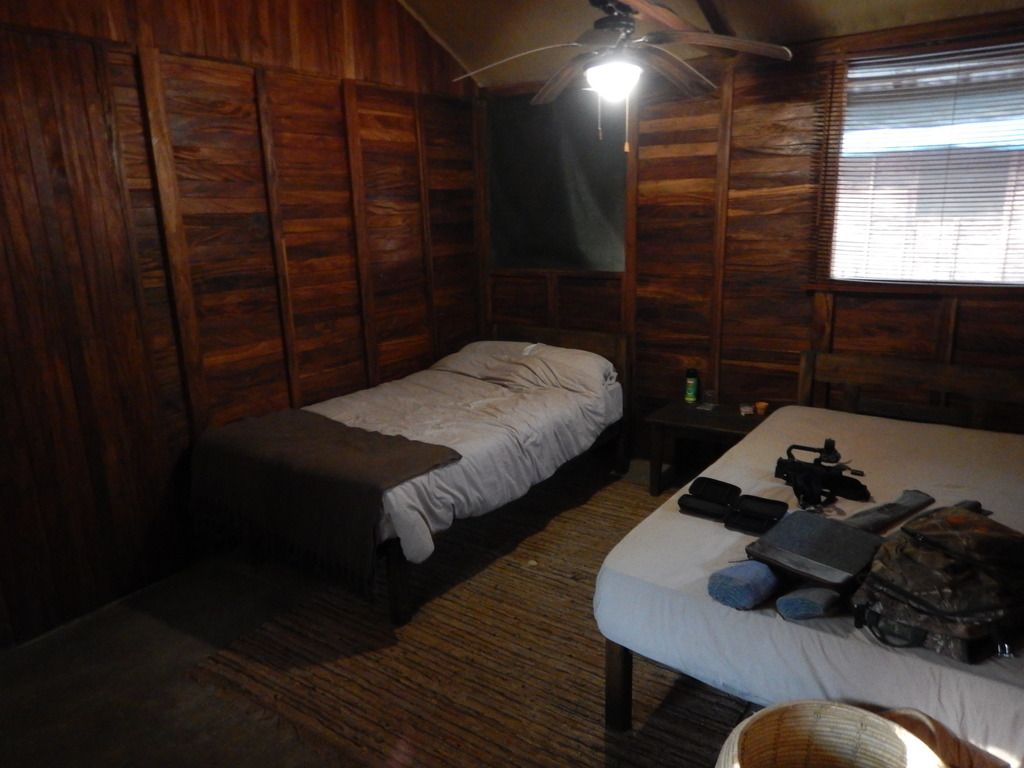 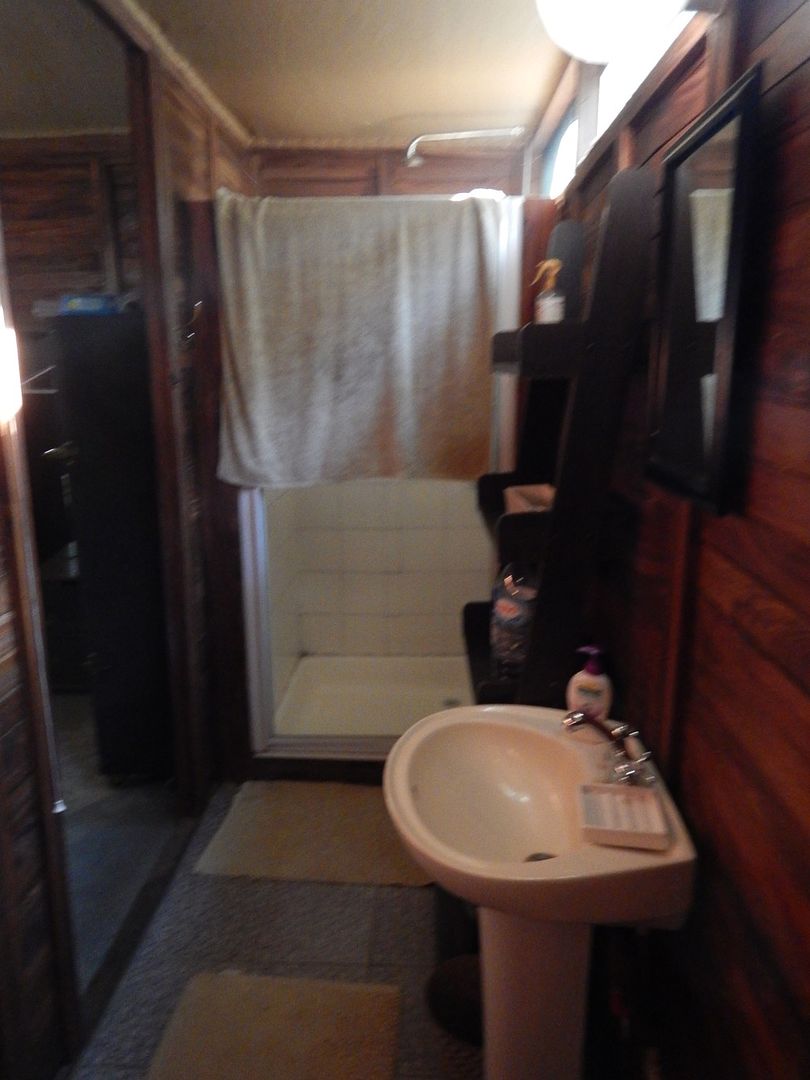 En suite bathroom Marromeu has a neat setup for power – they run the generator during the day only. That charges batteries that supply light in the chalets after dark. You can charge any batteries or anything that requires charging during the day while the generator is running. There was no power outlet available in my chalet, though one of the other guys said he had one in his. This means that you have the benefit of electricity at night without the noise of a generator – something most people appreciate. In our case it made things a little difficult because we had three professional cameramen with us who had substantial needs to charge batteries and to run laptops each evening. Anton “made a plan,” as they say, and our cameramen were taken care of. The PHs and staff stay in a separate camp about a mile from the camp where the clients stay. This wasn’t really any issue for us – the PHs explain that this is beneficial for clients because they can have the staff working in their “shop” and making noise without disturbing the clients. The only drawback was that the PHs needed to drive between the client camp and the PH camp, and that meant that they were often not around at breakfast time. Sometimes they came around early, but other times they showed up just as it was time to leave. Nearly every night they hung out with us after dinner and enjoyed a cocktail by the fire, only heading back to their camp when most of the clients headed to bed. The food was decent. Like a lot of places in Africa, the soups were outstanding. The wine was also very good – they served several different Portuguese vintages. Early in the safari the main courses consisted mainly of chicken and a vegetable. Once we got some game meat in camp we ate that – most of which was relatively simply prepared but fine. 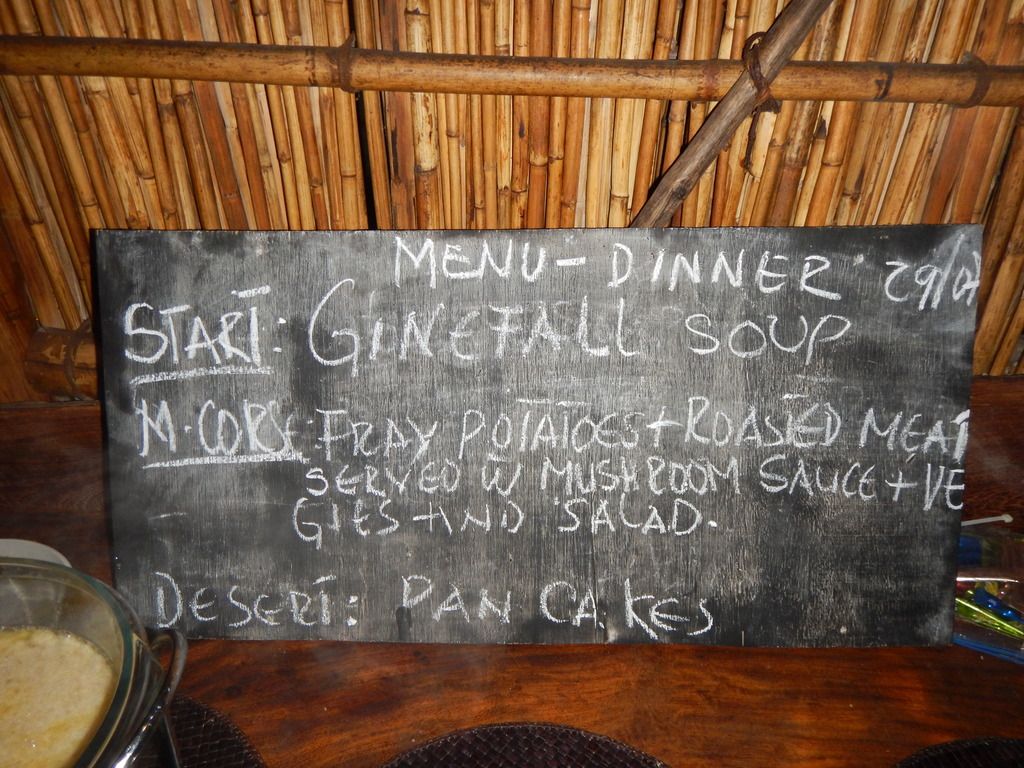 Dinner Menu Lunches were better than they’ve been on other safaris I’ve been on, not as good as others. Usually lunch consisted of a sandwich, bag of chips, piece of fruit, chocolate bar, etc. Anton felt the lunch quality was lacking about halfway through the safari and promised an improvement. The next day we got a much better lunch. 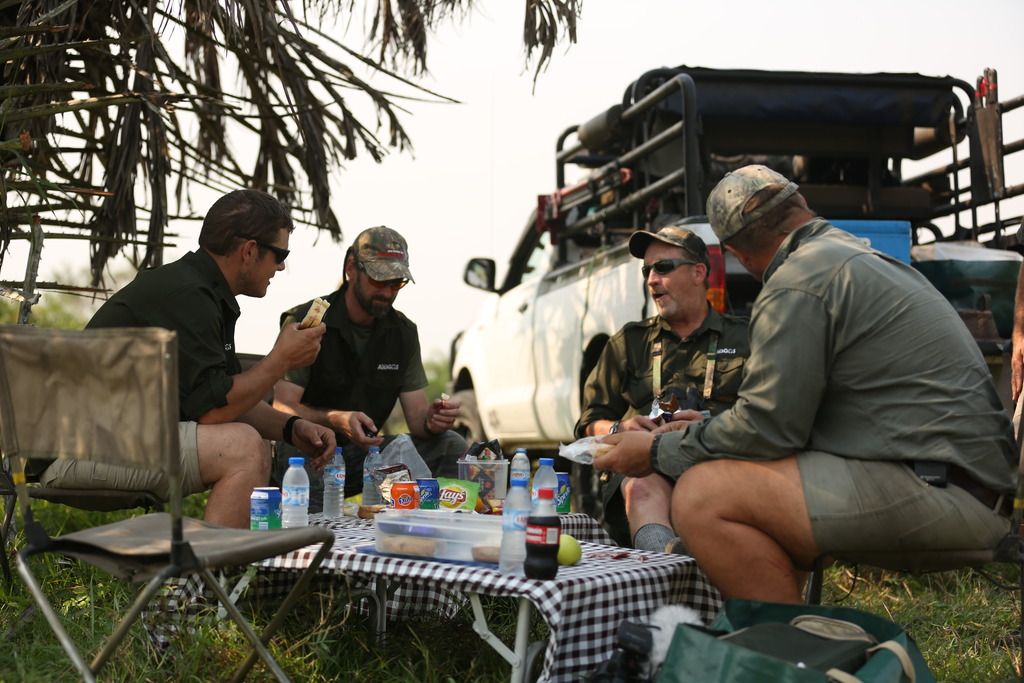 Lunch in the Field Breakfast wasn’t great but then again we didn’t complain or raise a fuss. Anton specifically told us that if we wanted anything other than cold cereal for breakfast all we needed to do was ask, and as far as I know no one ever did. Most of the guys had cereal and milk for breakfast each morning with a piece of toast. I pretty much stuck to coffee. I brought 50 packets of Starbucks VIA instant coffee (like I always do). Those were gone by Day Seven and we were stuck drinking the local instant, which is not good. If you like good coffee, bring more Starbucks instant than you think you’ll need. The Area The hunting area contains essentially three separate types of terrain. First, there is the deep forest. I spent a lot of time there because I was mainly targeting the forest duikers. The blue duiker and the suni basically never emerge from the deep forest. You can find other species there too, including bushbuck and nyala. 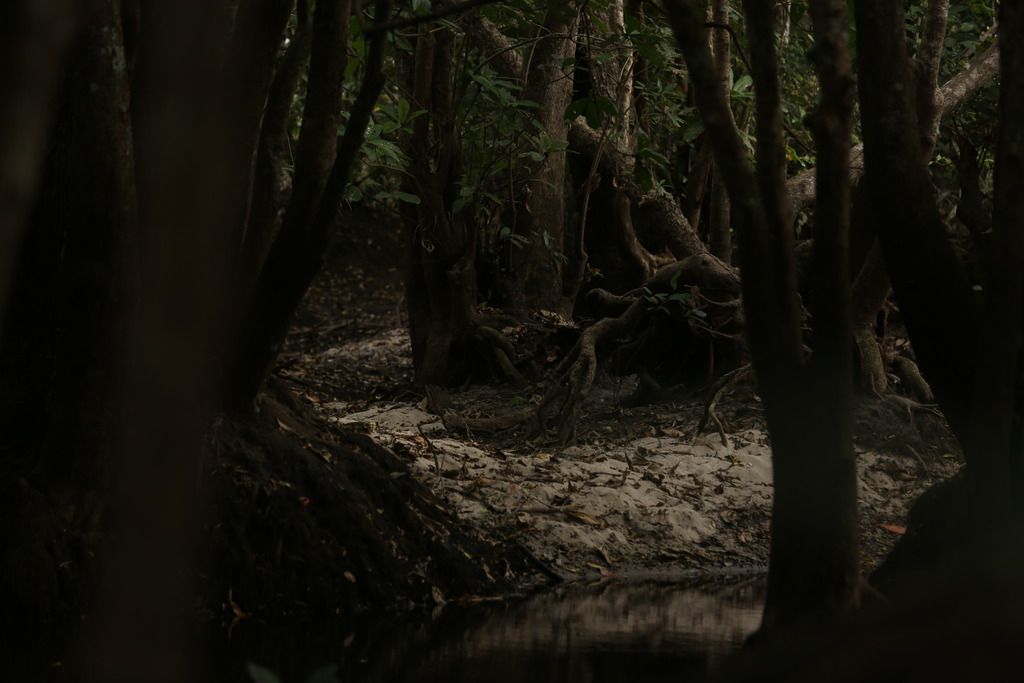 The Deep Forest Second, there are broken areas of small “islands” of forest surrounded by more open patches of tall grass and scrub. Pretty much all of the species can be found there. Red duiker come out mid-morning as the sun comes up and burns off the mist, to feed in the tall grass. You see them along the forest edges. Sable, Lichtenstein’s Hartebeeste, Livingston Eland, Warthog, Bushbuck, Nyala – we often saw all those species in the broken patches of tall grass and scrub. 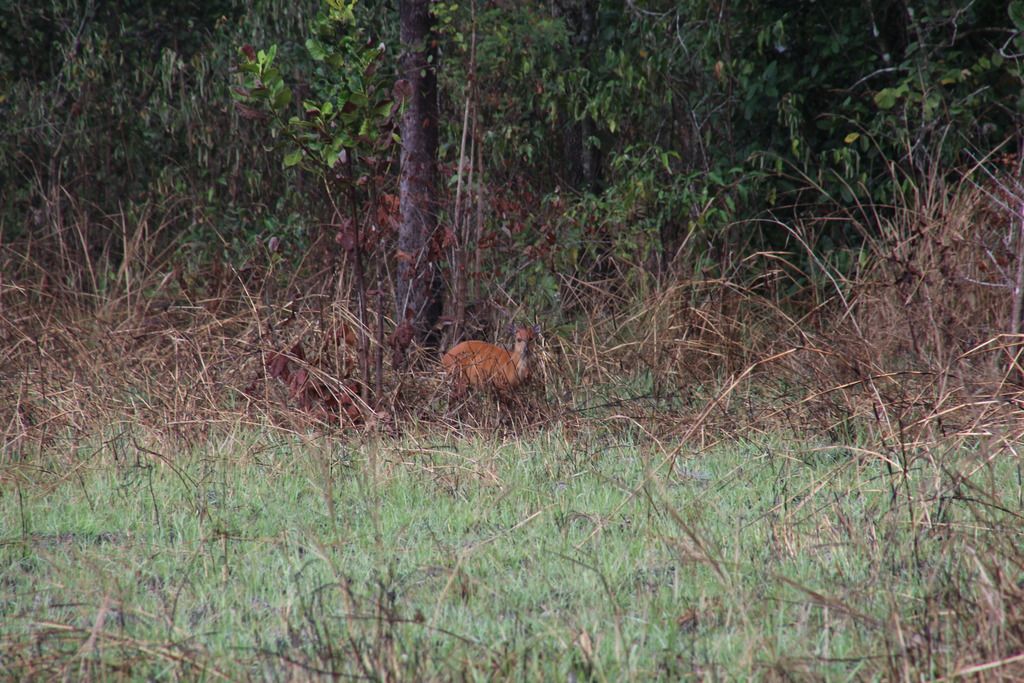 Red duiker on the edge of a forest "island" Finally, there is the swamp. This is what makes Coutada 10 a truly unique destination, though I didn’t personally get out there (for reasons I’ll discuss below). Most of the guys in my party headed into the swamp looking for buffalo. To access the swamp, you first drive an hour and a half to two hours to Argo camp, where you board an Argo and venture another couple of hours into the Delta. I’ve seen the video and it looks hairy – lots of pushing, pulling, and poling the Argos through the reeds. I’ve never ridden in one, but am told they are hot, noisy, and generally uncomfortable. Still, the guys in my party seemed to enjoy their trips out to the swamp and back, and a couple took nice buffalo out there. If you’ve hunted buffalo in other places and are looking for something a little different, this is perfect. Actually, that describes me, but I STILL missed out on the experience, because taking a buff with my double was the more important experience, and I had an opportunity to do that on the “swamp line,” which is a broken area of palms and forest bordering the swamps. 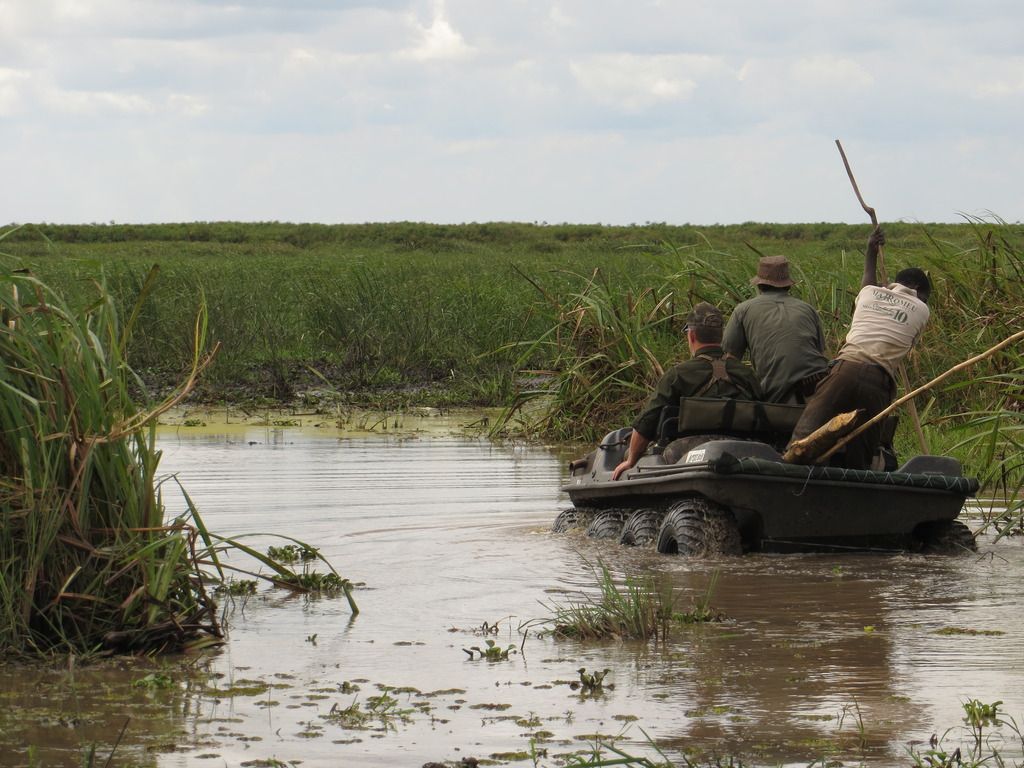 The Swamp 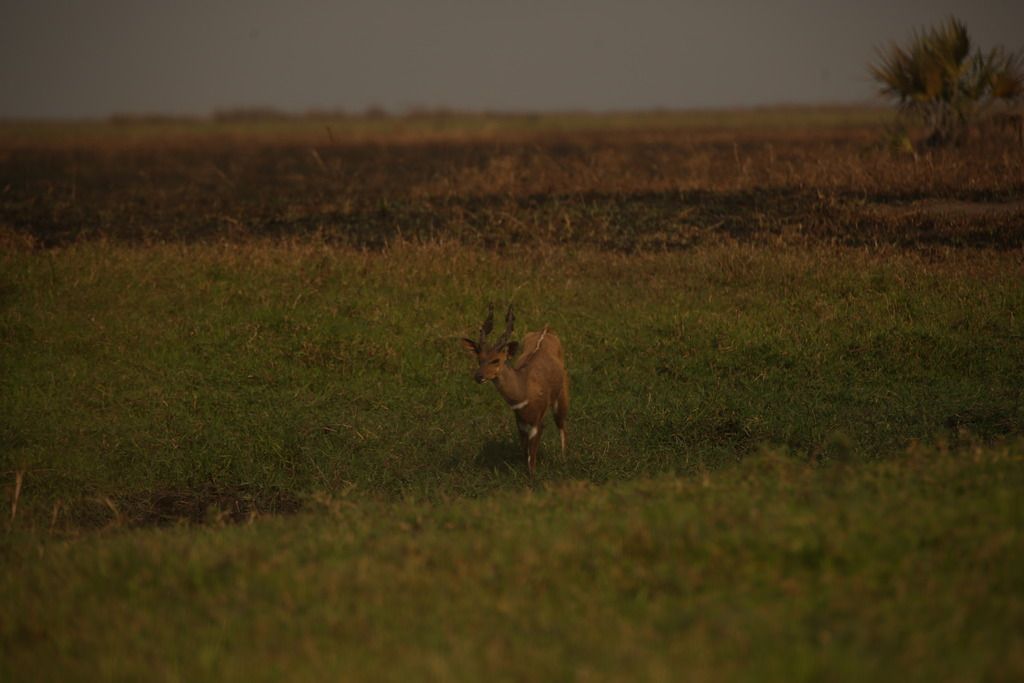 Bushbuck on the "Swampline" The Game This area is packed with game. You see game within minutes of leaving camp every day, and you pretty much see game everywhere you go. The most prevalent species is unquestionably warthog. I have five warthogs already and promised my wife I wouldn’t shoot another one. I shot another one anyway, and so will you if you hunt this area. There are times when you’ll drive for 45 minutes and there will be warthogs in view the entire time. Guaranteed you will find a warthog that you cannot allow to continue walking. The other species you see every day in this area are: Roosevelt Sable, Common Waterbuck, Common Reedbuck, and Lichtenstein’s Hartebeeste. Trophy quality on these species is high. If you are looking for an outstanding Waterbuck or Reedbuck, in particular, I doubt you can do better elsewhere. I’ve never seen better quality Waterbuck or Reedbuck anywhere. I have several of both of those species but could have easily shot better ones here if I wanted. The Sable looked really good to my eye – I already have two and elected not to shoot one on this trip, but three of the other four members of my party shot them (and the fourth also did not want one). If you really want a really outstanding Sable you may or may not find the one that you really want, but there is no question you can shoot a really good Sable if you want one. I only saw a single Cape Buffalo (on my second day) and it met all of my criteria – it was a very old bull with a worn boss and it was in a perfect position for a close stalk that let me take it with my double. And so I did. I have several high scoring buffalo. That isn’t a big motivator for me any more. Age and experience are far more important to me now that I have some big ones in my collection. This buffalo is probably about 37” – I didn’t measure him and won’t because I truly don’t care. My impression of the trophy quality of the buffalo in this area from the trophies the other guys in my party took (and three of the other four guys took buffalo, the fourth was a bow hunter who did not hunt them) is that they are pretty average. Most appeared to my eye to be about 38”. All were fully mature, hard bossed bulls. All but mine were taken out of herds. Mine was a dugga boy off completely by himself. The other bulls I saw in the video of the herds also appeared to my eye to be pretty average buffalo. There may be monsters there, I just didn’t see any myself or in the video. If you want a decent buffalo and are looking for a unique experience, this is the place for you. If you want a huge buffalo that will put you in the top 100 in the record books, send me a PM and I’ll offer you my 2 cents on how to get that done. Not that I encourage it – I’m fully onboard the Doctari Robertson agenda to shoot OLD bulls, not high scoring bulls. The Amigos “Take” Here’s a breakdown of the game the “Amigos” took while in Coutada 10: Day 1: Ron – Bushbuck Dave – Reedbuck, Sable Mike – Bushbuck (bow), Francolin (bow) Me – Blue Duiker Day 2: Ron – Cape Buffalo Mike – Warthog (bow) Me - Cape Buffalo (double rifle), Warthog Ken – Ill Day 3: Me – Oribi Dave – Ill Day 4: Ron – Oribi, Reedbuck, Waterbuck Ken – Cape Buffalo Mike – Warthog (bow) Me – Red Duiker Dave – Still ill Day 5: Ken – Waterbuck Dave – Cape Buffalo, Warthog Me – Livingston Suni Day 6: Mike – Sable (rifle), Warthog (bow) Ron – Sable Ken – Sable Me – Bushbuck Day 7: Dave – Red Duiker, Bushpig, Nyala Mike – Francolin, Crested Guinea (bow) Day 8: Me - Reedbuck (bait for incoming leopard hunter), Warthog (same) Mike – Nyala (rifle) Dave – Blue Duiker Ken – Warthog Mike S (Cameraman) – Reedbuck (bait for incoming leopard hunter) Day 9: Me – Baboon Ron – Warthog, Lichtenstein’s Hartebeeste Mike – Waterbuck (bow) Santi (Cameraman) – Francolin (bow) Day 10: Mike S (Cameraman) – Baboon My Hunts As mentioned earlier, I had two goals for this hunt. First, I wanted to take a Cape Buffalo with my double rifle. I have shot buffalo in South Africa, Zimbabwe, Zambia, and Tanzania. Most of those hunts were fairly typical buffalo hunts. I shot my buff in the APNR bordering Kruger in South Africa with a Ruger No. 1 in .450-400, the rest were shot with scoped magazine rifles in .375H&H. Only one of my bulls prior to this hunt was a dugga boy, the rest were herd bulls. I wanted the experience of getting very close to an old dugga boy and taking him with my double. My second goal was the forest duikers. I am working on my Tiny 10 – I have several steenboks from Namibia, a klipspringer, a Vaal rhebok and a couple of bush duikers. A mountain reedbuck if you count those as part of the Tiny 10 (they’re small, but I wouldn’t include them). I wanted to focus on the red duiker, blue duiker and oribi in Mozambique, but I especially wanted a Livingston Suni. Most of my compatriots on this hunt just wanted buffalo and sable and the stuff this area is best known for – reedbuck and waterbuck, etc. So I was the unusual one, as usual. Blue Duiker My hunt began with the search for duikers. Duikers are hunted in the forest in this area primarily by sitting and calling. Anton recruited one of the skinners, Sebastian, to come along with us to call for duikers. Sebastian was the best among the staff at the nasal duiker call, and it definitely worked for us. We would drive to a patch of forest the trackers felt was promising, then check the wind and march a short distance into the forest and find a good spot to set up. Anton and I would sit against a tree with Sebastian and a tracker behind us. When everything was ready, Anton would signal to Sebastian and he would begin the nasal call. I suspect that duikers respond to this call more out of curiosity than anything else, but for whatever reason they do respond to it. We tried seven or eight different areas before we got our duiker on the first day. Once we had something come in but never saw it. Another time a red duiker came in behind us and spooked when he got our wind and before he offered any shot. The forest can be very thick – there are virtually no clear shots offered. A shotgun can work, and I used the camp 12 gauge for my suni (as set forth below) but for the red and blue duiker I used my Blaser R8 in .375H&H with a Leupold VX-6 in 2-12x, loaded with 300 grain North Fork Flat Point Solids. Sorry you Blaser haters, but it works for me. I actually don’t even want to like that rifle. It violates several of my beliefs, including the one about keeping the equipment as simple as possible. A Blaser is full of little bitty plastic pieces. But the frigging thing is a death ray and it comes completely apart for transit. The zero has NEVER shifted an iota even though I take it apart and put it back together all the time. It’s comfortable, it’s accurate, and it reliably kills stuff. I have my beliefs about rifles, but I don’t argue with what works. On maybe our ninth or tenth attempt that first day we finally heard a duiker coming in to the call. Anton waved to Sebastian and he stopped calling. And then there it was – not more than about 15 feet in front of me. Most of its body concealed in the brush. It’s head bobbing up and down as it looked over and under the thick brush, trying to work out what we were. Anton in his binos, trying to see the short little horns. When he whispered “take him,” I squeezed and the duiker disappeared. He just literally disappeared like a ninja in a puff of smoke. I figured I had hit him – my scope was down on 2x and he nearly filled it and I was comfortable. It was 15 freaking feet for crying out loud. And indeed I nailed him amidships as intended. He went nowhere. He had a hole that measured .375 low in the middle of his body that exited his underparts, removing most of his insides. Very little damage to the trophy, and a beautiful little antelope. I was elated. 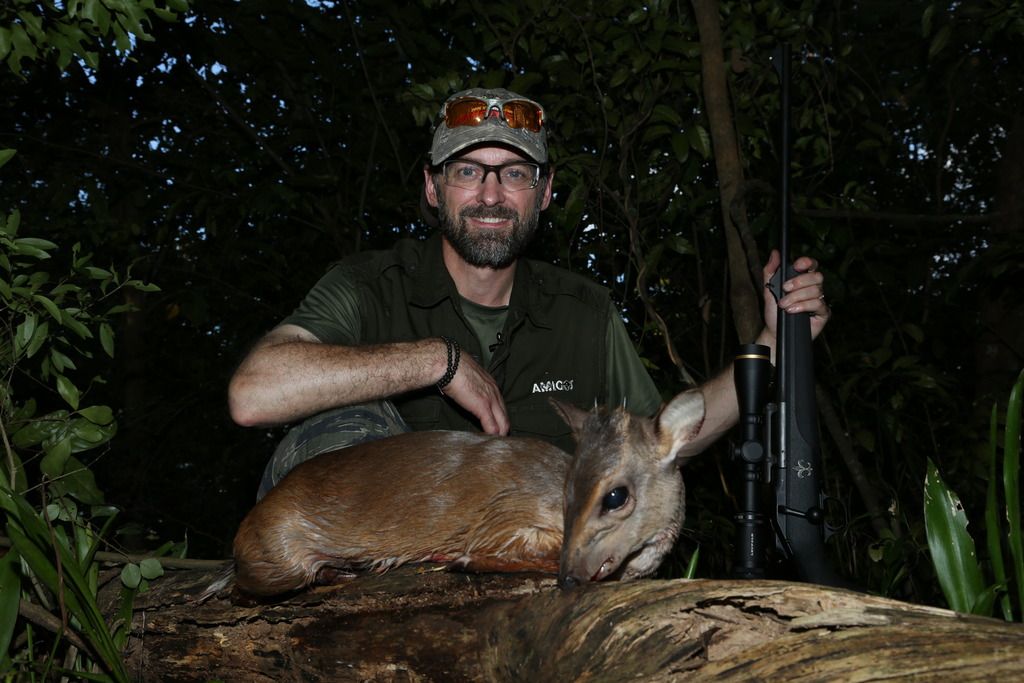 Blue Duiker Warthog As I mentioned earlier, I already have more warthogs than I need. Indeed, in an earlier hunt in Zimbabwe with the late Ian Gibson, I took an uncommonly large warthog. I needed another warthog like I need a hole in my head but Gibbo would have shot that pig if I didn’t. I had that one mounted life-size and promised my very tolerant wife there would be no more warthogs in our house. But Coutada 10 is overrun with them. You will see a LOT of pigs there. And some will be very big warthogs. You will shoot one. Even if you told your wife you wouldn’t. I am embarrassed to admit that I shot the pig I said I wouldn’t shoot badly, and worse, it was only the second animal I shot at on the safari. Nothing like showing your PH that you’re a regular guy on the second day of the safari. In my defense (I guess), we later estimated the range at about 250 yards and like a dumbass I just held right on him without making any effort to compensate for the distance. I was shooting 300 grain Barnes TSX bullets as my softs, with the scope “on” at 100. That first shot did hit him, low and amidships, as it turned out, but he ran off appearing unwounded. I took two more shots at him running. Neither connected. We followed. He gave me another chance and I put another one into him, this one low – just under his body – but it broke his off front leg. He went a little further and stood. Pow. Down for good like he was poleaxed. Five shots, only one of which was on target. But we put him down. 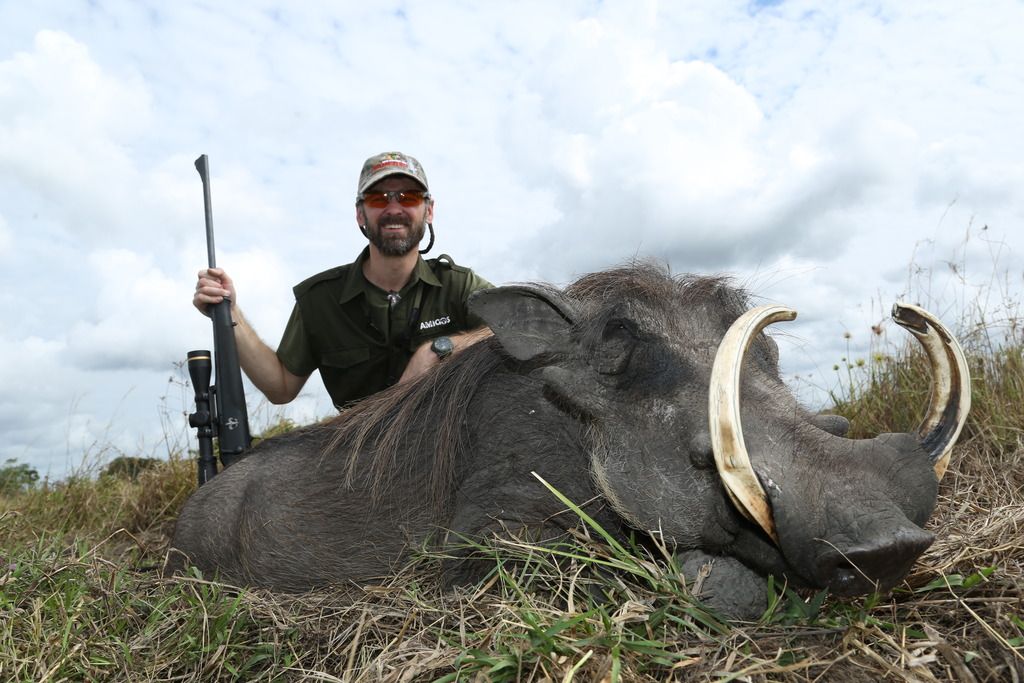 The Warthog I Said I Wouldn't Shoot I was frustrated but Anton was cool. He told me not to worry about it, that guys do it all the time. I told him that going forward if he could help me with range estimation that would be good – if he doesn’t give me a range estimation I’m going to assume a 100 yard hold will work. He agreed and that was that – it certainly wasn’t his fault I’m a dumbass and not competent to accurately determine range and hold on my own. Cape Buffalo Taking a buffalo with my double was an important goal for me. And as I said earlier, my trophy standard was simply that the bull be old. I wanted a fully mature, rock hard-bossed bull. I figured to do it with the double we’d need a dugga boy. But we went looking for a herd on the swamp line. Anton had one of the trackers climb a tree to look for birds to try to locate a herd late in the afternoon of the second day. And they found the birds, and with them the herd. But they were too far off for us to get to that afternoon. It didn’t matter. While the tracker was in the tree reporting how far off the herd was, my cameraman, Doug, said “Hey, isn’t that a buffalo over there?” With his bare eye he had spotted a lone buffalo way off to our right. “Yes,” Anton said. “Let’s go check it out.” The trackers had started to become a little unhappy with Doug, who in the first two days of the safari had been seeing a lot of game and pointing it out before them. I got the sense that they felt Doug was intruding on their turf a bit. They told Anton they thought the bull Doug spotted was a cow. We drove closer anyway. We got off the truck and I loaded the Merkel double with a 400 grain North Fork soft and a 400 grain North Fork cup point solid. “We’ll just go in and see what it is,” Anton said. “It may be a cow, or it may be a bull we aren’t interested in.” We walked in closer, using a big clump of palms as cover. The wind was in our favor, blowing nearly straight at us from the buffalo. As we stalked into the clump of palms, we could see it was a loan bull, feeding on the other side of what Anton would call a “river,” but most of us would consider a “stream,” at best. We were about 100 yards from him. Anton looked him over with the binos carefully. “Look, he isn’t the widest bull,” he said. “He’s probably about 37”. But he’s old, and his bosses are hard. There’s nothing wrong with his bosses.” I said, “He’s in a good spot, undisturbed, on his own, with the wind in our favor. We can get to him with the double and he’s fully mature. That’s what we want.” “OK,” Anton replied. “Let’s crawl in. If he looks at us, just lay flat.” And so we did. At one point, when we were perhaps 40 yards from him, he lifted his head and looked in our direction. We froze. He looked for a few minutes, then went back to feeding. We crawled to within about 20 yards – the stream (Anton referred to it as a “river”) was just in front of us. I slithered down the bank in front of Anton and got into a sitting position, elbows on knees. Now the buff heard us or saw us or something – he turned to face us, quartering to. I put the first North Fork directly through his heart. He ran from our left to our right looking at us, unsure of what he wanted to do about the thing that just stung him. As he was trying to make up his mind I hit him with the second barrel on the shoulder. He turned to his left and trotted away from us about 20 yards. I broke the double and reloaded with two cup point solids. Bam. .Bam. Two more in the boiler room and blood poured from his nose as I broke and reloaded again. I shot once more and knocked him over. Anton and I got up. I was absolutely elated. It was a great stalk, everything was in our favor. We walked to the buffalo and he was spectacular – an old bull with very worn and chipped bosses and big bald patches on his body where he was losing condition. This was exactly the kind of bull I wanted to take, and taken in exactly the way I wanted to take him. I thanked Anton and the trackers, Sebastian and Lovadu. Doug (my cameraman) told me he got awesome footage. The sun was setting as we got our pictures taken. That day my Amigo Ron also took his buffalo – way out in the swamps. 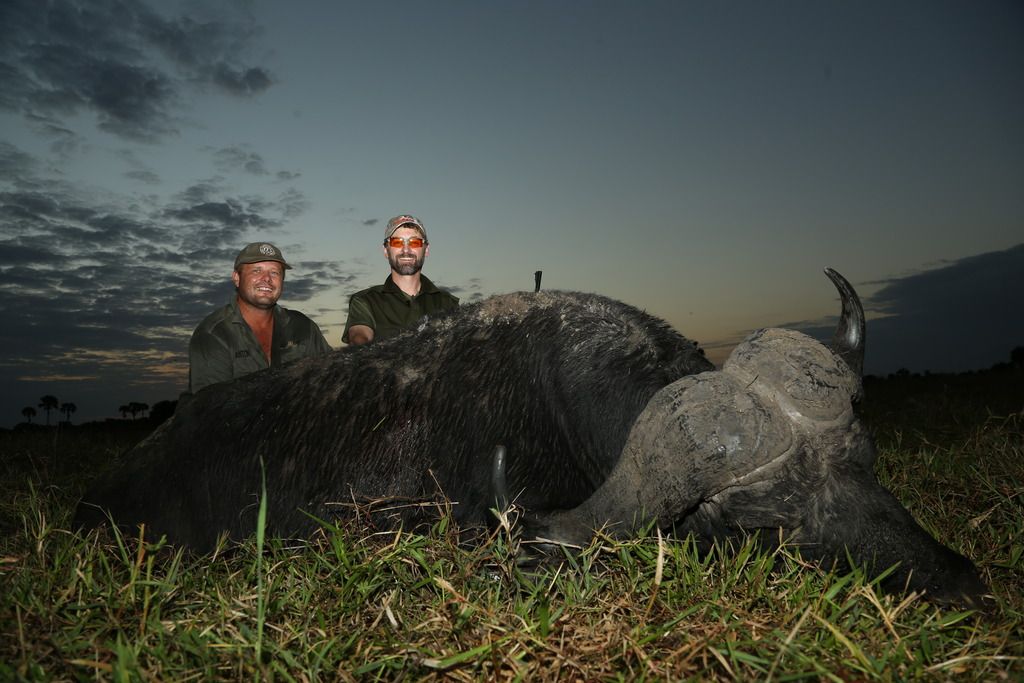 Cape Buffalo With My Double 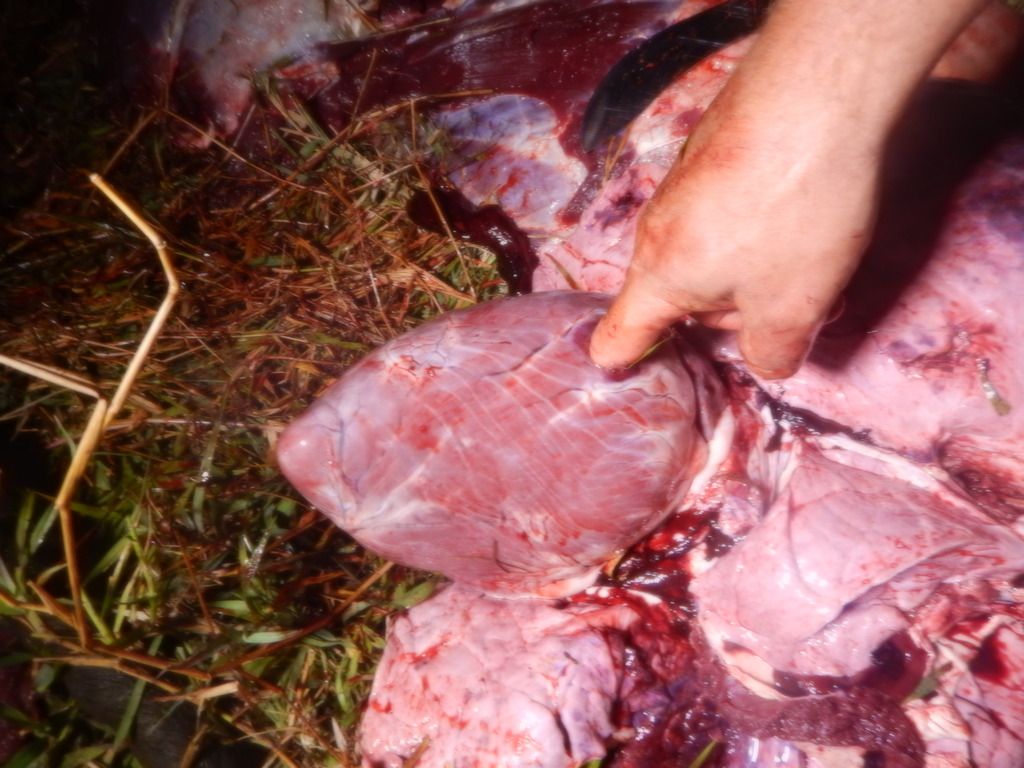 40 Caliber Hole in His Heart Oribi The next day we set out with a plan to find a suitable oribi. Oribi are really cool delicate little antelope, a little like a steenbok with long legs. They have long straight horns and like to hang out in tall grass. You usually find them in pairs, and they like to hold tight until you’re close, then bound off, often with a “stotting” motion similar to a mule deer or a springbok. In Coutada 10 there are certain areas that hold a lot of oribi. So the challenge isn’t really in finding them – you’ll find them. It’s more a matter of finding a male that meets your trophy quality requirements, then finding a way to get to him either before he knows you’re there or otherwise getting a good shooting position. As an aside, I am not a bow hunter but most of Coutada 10 seems to be heaven for bow hunters – lots of patches of cover interspersed with open areas that are often full of long grass, and the whole thing loaded with game. Having said that, I have a ton of respect for any bow hunter who can take an oribi with a bow. Those little guys are switched on. They let you get closer than some of the larger species before they take off, but they are wary, and when they go, they go. We looked over several oribi before we attempted our first stalk, which resulted in the oribi running like a bat out of hell. We didn’t see him again. Then we chased a pair around a big open area for about an hour. They would run maybe 200 yards and disappear in the tall grass. We’d walk in the direction they had run and they’d flush again and we’d wait for them to stop. I had one opportunity and a shot at about 200 yards on an oribi that was quartering to me. Probably a 3” circle of a target, so I’m not as embarrassed at that miss as I am about the poor shooting on the warthog the previous day. It came together for us in the early afternoon when we spotted an oribi in some tight cover and were able to stalk to about 50 yards or so. He was down in a clump of grass where he couldn’t be seen, but we knew he was there. We got the sticks up in another patch of cover and made a noise. He stood, I shot, and that was pretty much that. He ran maybe 50 yeards before he went down, but when we walked up to him he was done. The oribi was an important trophy to me – probably second only to the suni. 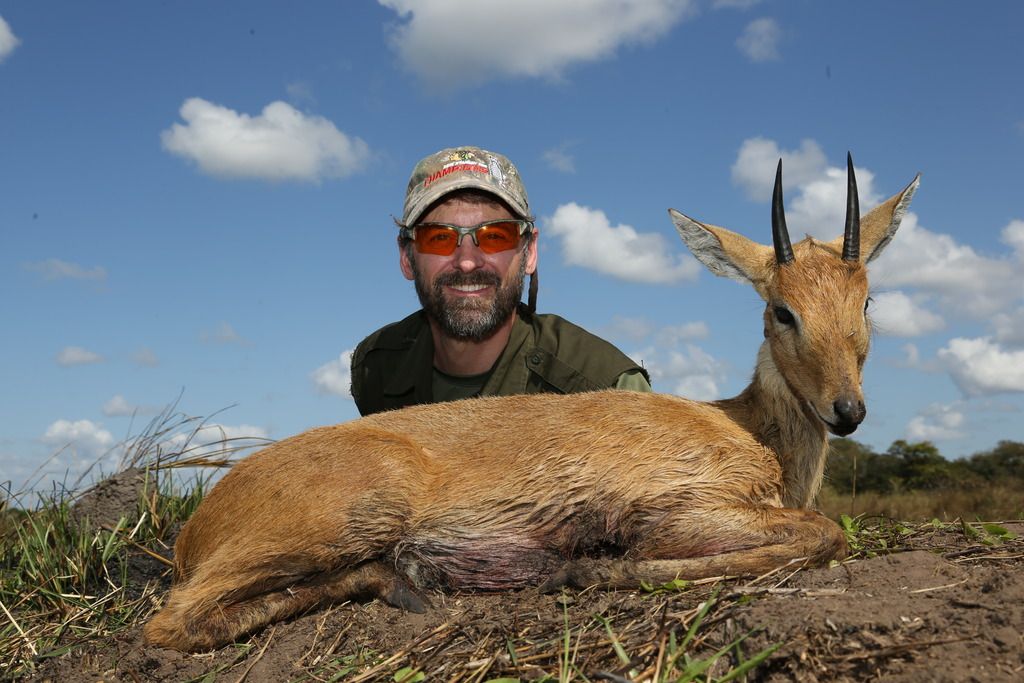 The Oribi Red Duiker The most frequently seen game in Coutada 10 is the warthog, without question. And out on the swampline there are big, big herds of waterbuck and large groups of reedbuck. But after these species I would say the species we saw most frequently was the red duiker. I only saw singles – I never saw two red duikers together. But every morning we would see red duikers on the forest edge, coming out to feed as the sun warmed the earth and the morning mist burned off. Red duiker are tough on a PH – only the males have horns, but the horns are short and rather than pointing up off the skull, the point backwards off the back of the head. Most vexing. When a red duiker looks right at you generally you can’t see horns. Both males and females have a tuft of hair on their heads, making it even more difficult to see the horns. You really need a profile of the head to confirm it is a male and to judge the quality. Red duikers do come to a nasal call, and we spent as much time sitting in the forest calling them as we did spotting and stalking them. As it turned out, the one I shot was spotted and stalked. Doug (the cameraman) saw him sneaking through the forest from the road. We marked his line and got ahead of him. Anton put me on the sticks about 75 yards from an anthill he had disappeared behind. “He’ll either come out the other side and you can shoot him there, or he’ll turn and head away from us and we’ll follow and set up again,” Anton said. Fortune was with us, and shortly we saw him slipping through the trees that ringed the anthill. When he emerged into the sunlight and began to feed, I fired a 300 grain flat point solid and he was mine. 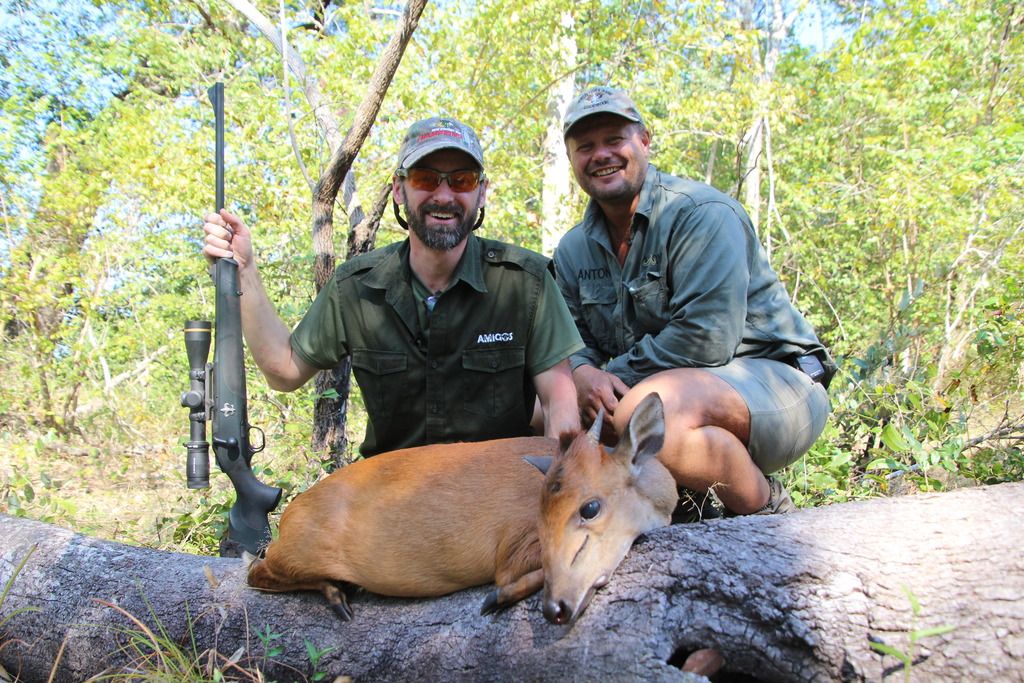 The Red Duiker Now that I had my blue duiker, my red duiker, my oribi, and a cape buffalo with my double, I was ready to call the whole safari a smashing success and it was only the fourth day. Sadly, this was the day my cameraman crashed a $3,500 drone. He was getting awesome aerial footage of game, the truck driving down the track, etc. Doug is a truly excellent drone pilot – I’ve seen other guys fly drones but he’s really a natural with it. We had returned to camp mid-day with the red duiker and Doug had been flying the drone over and behind the truck on the way back. He dropped it down and flew it into the little parking area outside the camp, which is under a forest canopy. He committed two errors. First, he neglected to realize that his battery on the drone had dropped as far as it had. Second, he had programmed the drone to automatically return to its “home” when the battery reached a certain level, and to return “home” he had programmed it to first climb to 30 meters. Ironically, he did this to ensure it would clear any obstacles between wherever it hit that level of battery depletion and wherever the “home” point was. He had set the most recent “home” point several hundred yards down the road. So the drone began to climb to 30 meters to fly home because its battery was depleted. It overrode his frantic effort to reduce altitude. And it flew right into the branches of the trees over camp, stopping its propellers. It fell like a brick. The $500 4K video camera hanging below it was smashed so thoroughly that the mini-SD card inside was snapped in half. We weren’t even able to recover any of the footage he had shot so far. We were sick about it, and of course Doug felt even worse. Fortunately one of our other camermen – Mike – who was filming my Amigo Ron – had a second drone. Mike’s wasn’t quite as fancy as Doug’s, but at least we have some decent aerial footage for the annual Amigo video production. And Doug had his drone insured, so financially it isn’t a total loss for him, though he had several jobs for other clients lined up in which the drone had been a key component and would now need to be replaced. Doug is from Zimbabwe, and it isn’t so easy to just replace a $3,500 drone in Zim. 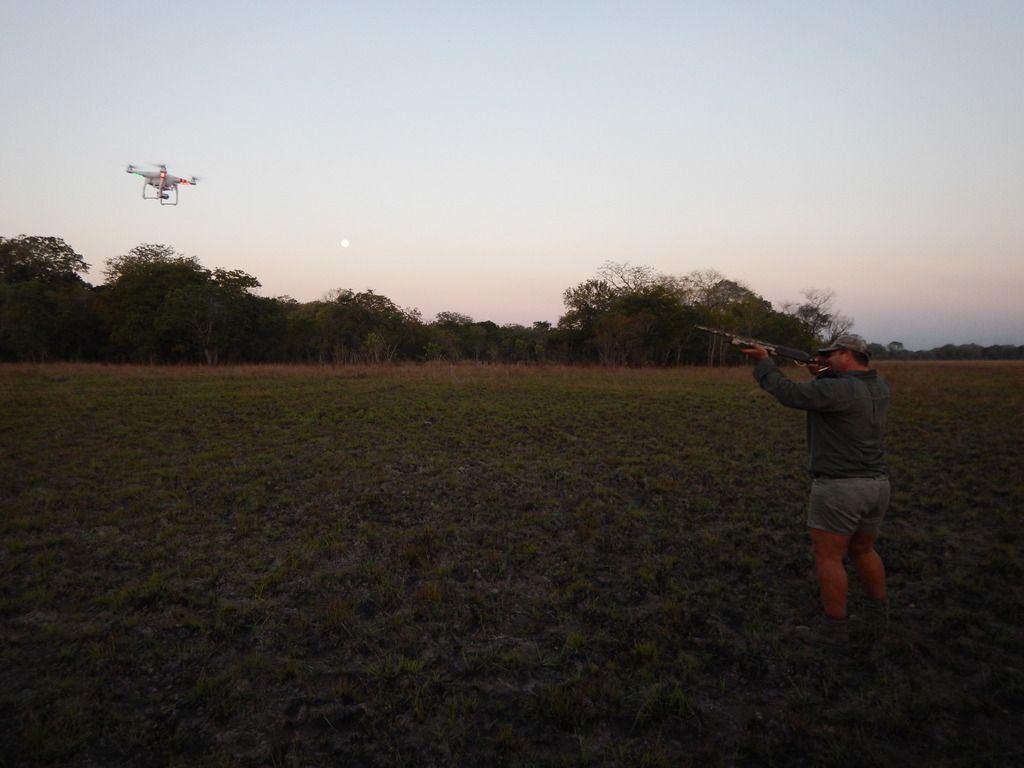 Anton Threatens The Backup Drone Livingston Suni The only forest duiker I hadn’t yet taken was the Livingston Suni. They have them in Coutada 10; they love the deep, dark, dense forest. One of the trackers reported seeing one on the fourth day of the safari, but I didn’t see it and even he didn’t really seem all that certain that what he’d seen was a suni. I had the impression that they are occasionally taken incidentally in Coutada 10 – perhaps you’re calling for duikers and one comes in, or perhaps you’re walking through the forest and you stumble across one. But my impression was that if you truly wanted to target the species, there is a different plan. That plan involved leaving Coutada 10 for Coutada 12, which has much more “Suni Forest.” Apparently the guys at Marromeu have an arrangement with the guys who hunt Coutada 12 in which they trade some of their quota for certain species. For example, the waterbuck in Coutada 10 are simply outstanding – plentiful and very high quality. They’re a bit thinner in Coutada 12, so if the guys in 12 have a client who really wants an outstanding waterbuck, they come over to 10 for one. For suni, when Marromeu has a client (like me) who really wants a suni, you make a 3 hour drive over to 12 to hunt them there. Ron also wanted a suni, so on Day 5 of our safari we teamed up. Our PHs teamed up as well, and the four of us, along with a cameraman and two trackers, drove over to 12, arriving just before lunch time. On the way to the main camp in 12 we passed through some suni forest and saw no fewer than what I would estimate as 75 or so suni. There were simply tons of them. After checking in with the guys in the main camp we set out. Ron and I agreed that I would shoot first. On the advice of Anton and Quenton (Ron’s PH), we elected to shoot the camp shotgun, a beat up Remington 1187 with a barrel that was maybe 16” long. To hunt suni, the hunter, PH and cameraman would sit on the tailgate of the truck while we drove slowly down the road through the suni forest. When the PH or tracker spotted a suni – mainly by looking for their little white tails, which are constantly flickering, the hunter, PH and cameraman would bail off the moving truck, which would carry on down the road several hundred yards before stopping. Most of the time the suni would remain standing where it was in the forest, unless it got the wind of the hunters or spotted them. If the truck stopped too quickly, it would spook. Once off the truck, the challenge was to get to a spot where you could see it and where you would be in range. Often you would bail off the truck and by the time you got to where the PH or tracker had spotted the suni, it would be gone. Often the PH would look at it and pronounce it to be “m’fazi” – female. My first time off the tailgate I bit the dust. I valiantly tried to keep the muzzle of the shotgun from eating too much sand. But it ate some sand anyway. I scrambled to my feet, glad to see Mike’s camera was pointed at Anton and not back at me. Later he asked me about it. “What happened that first time off the truck?” he asked. “All I heard was ‘thump-bumpity-bump’ but when I turned around you were staggering to your feet.” “Well,” I said, “I lost my balance a bit but recovered quickly.” Which was more or less the truth. Despite having actually laid down on the road for a fraction of a second, I bounced up pretty damn quick. I got better. By the tenth time we jumped off the tailgate I was pretty smooth. And it took a good ten or twelve times before we had a male suni dead to rights. Unfortunately, the pattern of my shot left no blood on the forest floor, and a lot of pellet holes that appeared higher than the suni was tall. My second shot about 45 minutes later was no different. “Are you lining up the beads?” Quenton asked. “Beads? Plural?” I replied. Sure enough, there’s a frigging back bead on the frigging shotgun. Make that a ‘half bead’ at the back. Barely visible. I had been shooting like I shoot my Beretta O/U at clays – put the front bead on the target and shoot. That will result in shooting over the target every time with this particular gun, which has a little bitty back bead on the rib. You had to bury the front bead behind that little back bead and then put the whole thing on the target if you wanted to hit anything. “OK, the next suni we line up on is dead,” I said. And so it was. The next time we jumped off and Anton confirmed it was a male I shot it dead to rights and had my suni. Sadly, I had burned a lot of time not knowing how to shoot the stupid shotgun, leaving Ron only about 2 hours of hunting light. Still, he had three opportunities to shoot suni. His first two shots were misses, just like my first two shots had been. Where I struggled with how to operate the shotgun, Ron was having difficulty seeing the little bastards before they melted into the forest. Finally he connected with the third shot. We found good blood but were unable to find his suni. I felt – and feel – guilt over burning too much time early on that we were unable to find his suni before the sunset. Ron buddy, I’m sorry. 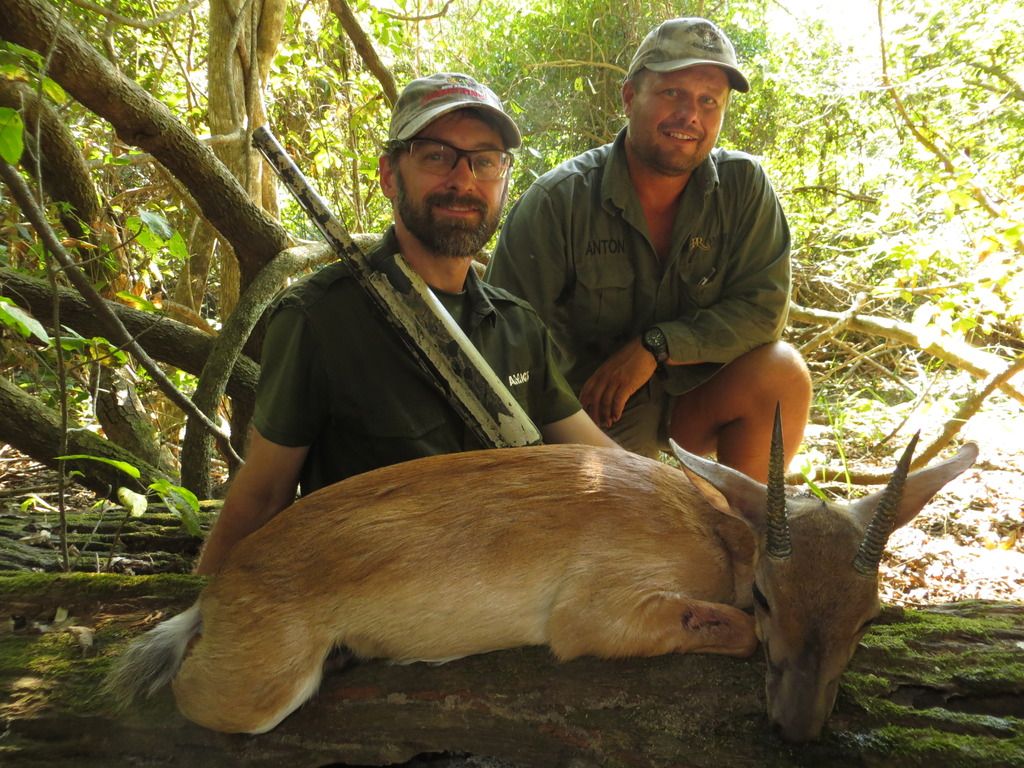 Livingston Suni Bushbuck With all four of my forest duikers in the salt and having taken the buff with my double, I had accomplished all my goals for the safari, and it was only half over. So on day six we took it easy, driving around and just looking over game. I would have been happy to shoot a Livingston Eland – they were not too common but we did see some herds, albeit none with mature males in them. I would have been happy with a high quality nyala, but though we saw some bulls, none were really that moving (note that my Amigo Mike P shot a nice one using Ron’s rifle – nice enough that he handed the tracker his bow and asked for the 7mm RUM). Good nyala are there but unless you are focused on them you’ll need to be lucky to get a really good one. We halfheartedly looked for a buffalo that a previous client had wounded in the brisket and leg. I really wanted to take that buffalo down. I wouldn’t get the trophy – that would go to the client that put the first bullet in it. But it troubled me that there was a wounded buffalo still out there, and I love to hunt buffalo, so just having the experience of finding it and putting it down would have been cool. We didn’t find it. However, in the afternoon we did find a bushbuck ram out feeding on the swampline and put a nice stalk on him. We got nice and close – maybe 40 or 50 yards. My first shot into him wasn’t bad, but he ran – straight toward us! I swung on him like a quail and touched one off about half a body length ahead of him. He stumbled but didn’t go down. He ran into a thick clump of brush to my left and I gave him an “Amigo heart shot” right in the pooper. He disappeared. When we approached we found him stone dead in a warthog hole where he dropped to my last shot, which hit him square in the butt. My other two shots had both been hits but it was that last one that dropped him. 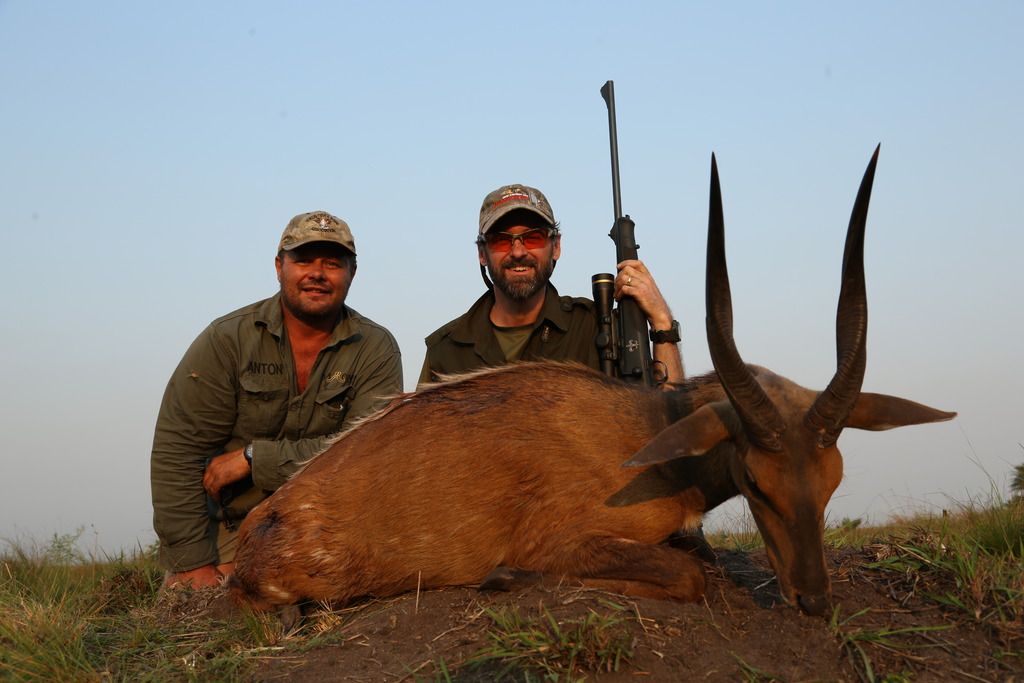 The Bushbuck Baiting Anton had a leopard hunter coming in as soon as we left, and he asked me if I would help him shoot and hang baits. “No problem,” I told him. Coming off a 16 day lion hunt in Tanzania in October, I was familiar with the work of cat hunting, but it’s even more fun (if that makes any sense) when there’s no pressure on you. So on the Eighth Day I shot both a warthog and a reedbuck and Anton and I drove around to find likely spots to string them up. Two of our cameramen were fortunate enough to be allowed to shoot reedbuck for bait as well. The previous day (the seventh day) I went out with my Amigo Dave and just filmed while he had an epic day – taking red duiker, bushpig and and nyala. Baboon I really like shooting baboons. Perhaps there is something wrong with me. But for whatever reason, stalking and shooting a baboon really trips my trigger. Although I have shot a number of them, I never hesitate to try to take another. So on our Ninth Day we went out to find a troop of baboons. It was harder than we expected. We looked all day but it was nearly sunset before we found the right situation, with the troop moving from left to right about 100 yards out. When the right male came across, I let him have it. He wasn’t sure where the shot came from and didn’t know he was dead (he was dead) and ran back and forth for a second like a duck in a shooting gallery. Then he headed straight away from me and I dumped him with a second shot. The following day I offered to pay for a baboon for one of our cameramen who really wanted to shoot one. We were screwing around getting some GoPro video on the vehicle when I heard a shot ring out. While Doug and I were working out how to get enough dust in the air to get a really cool photo of sun rays coming through the forest, Mike S had taken my Blaser forward, run into a troop of baboons, and picked out and shot a big male. As it turns out, most of the action wound up being caught on the GoPro mounted to the windshield of the vehicle! Anyway, Mike S was pretty happy with his big ass baboon and I couldn’t be happier for him. 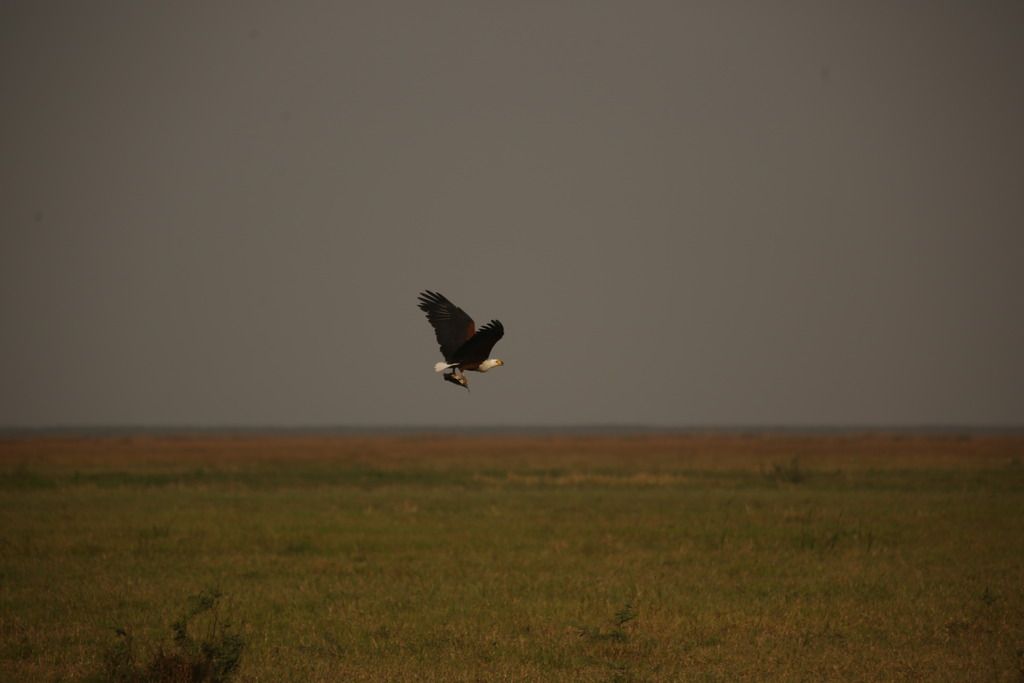 Snake Eagle with Turtle He Scored Right In Front of Us PH Evaluation My PH was Anton Smit. Anton met all my requirements for an excellent PH. He understood my goals for the hunt and worked hard to accomplish them. And met them. I put more importance on the effort than the results, but in Anton’s case he delivered both. He never pushed me to shoot trophies I wasn’t interested in. He was competent and fun to be around. He put together good plans and executed them well. 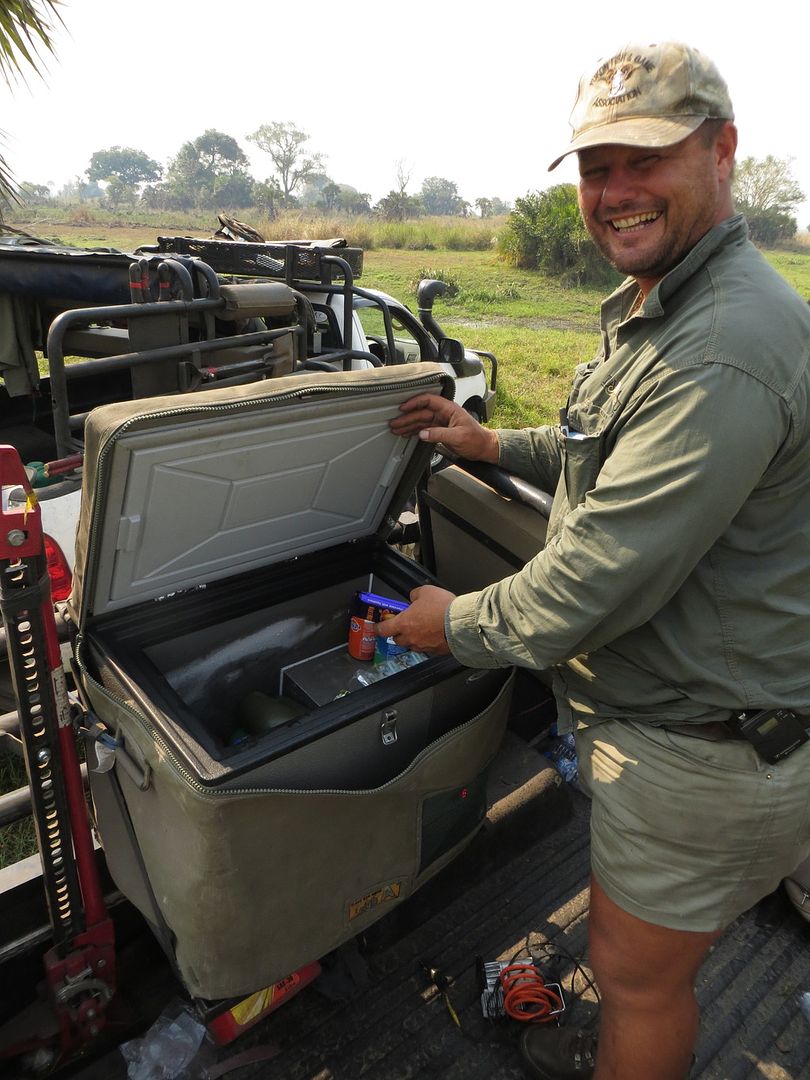 The Ice Cold Refrigerator on Anton's Truck 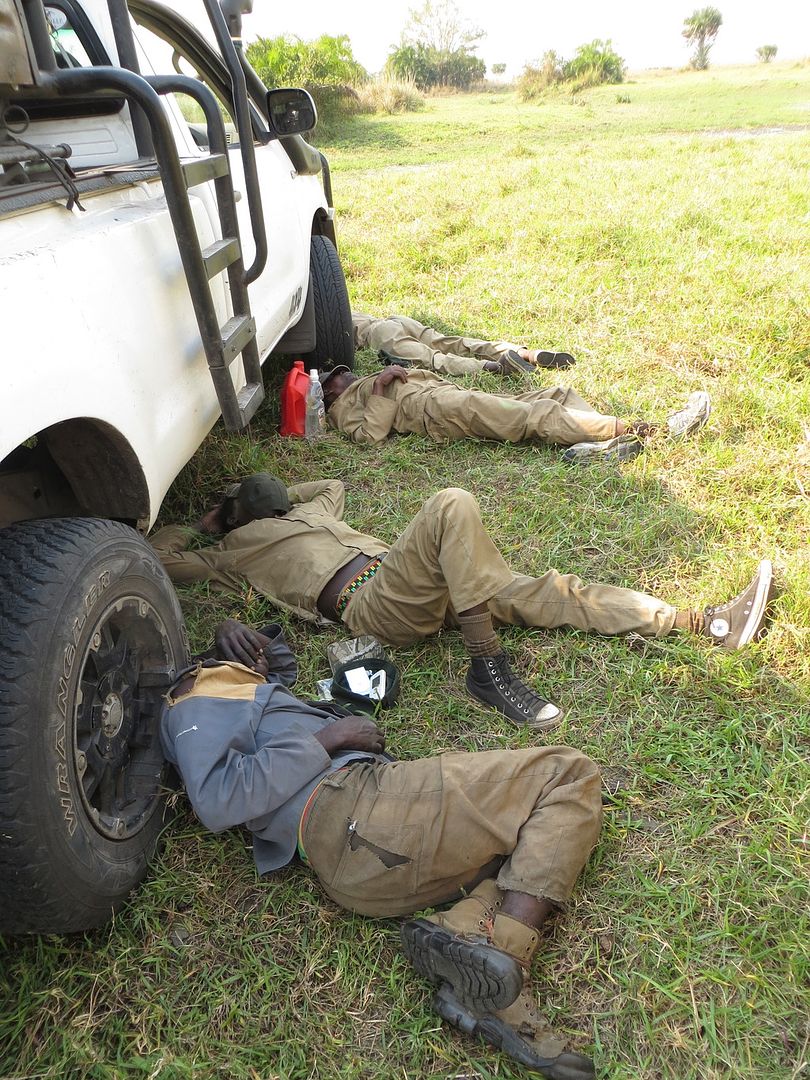 Tracker Naptime  Conclusion I recommend this hunt. Marromeu is well-organized and well-managed. This is particularly impressive since they are located in Mozambique, one of the less-organized and less-well-managed countries I have visited. Beira was a mess. The airport was a pain. But Marromeu has its act together and delivers what it promises. If you want a hunt in a unique area, or if you’re particularly interested in Sable, Waterbuck, Reedbuck, or the forest duikers available in Southern Africa, I’m not aware of a better destination. For buffalo it seems fine – there’s no shortage of them, as long as you’re willing to ride an Argo out into the swamp to get to them. | ||
|
| One of Us |
Excellent pictures and report. Thanks, Mike | |||
|
| One of Us |
Tom Thank you for taking the time to put together this fantastic report. You guys had a blast!! | |||
|
| One of Us |
Excellent report, great writing style and I one can really follow how rewarding it is to pursue own safari goals instead of inches. | |||
|
| One of Us |
Excellent read, thanks for sharing. | |||
|
| One of Us |
Outstanding report. Great write up and excellent pictures. Thanks for sharing. The danger of civilization, of course, is that you will piss away your life on nonsense | |||
|
| One of Us |
Nice Report Amigos..Thanks | |||
|
| One of Us |
outstanding photos and report. Paul Smith SCI Life Member NRA Life Member DSC Member Life Member of the "I Can't Wait to Get Back to Africa" Club DRSS I had the privilege to fire E. Hemingway's WR .577NE, E. Keith's WR .470NE, & F. Jamieson's WJJ .500 Jeffery I strongly recommend avoidance of "The Zambezi Safari & Travel Co., Ltd." and "Pisces Sportfishing-Cabo San Lucas" "A failed policy of national defense is its own punishment" Otto von Bismarck | |||
|
| One of Us |
Excellent! I really enjoyed your report, story and pictures. Also packed with good information. | |||
|
| one of us |
Gorgeous pictures and great trophies there. Thanks for posting. Frank "I don't know what there is about buffalo that frightens me so.....He looks like he hates you personally. He looks like you owe him money." - Robert Ruark, Horn of the Hunter, 1953 NRA Life, SAF Life, CRPA Life, DRSS lite | |||
|
| One of Us |
Well done! Thanks for posting. Moz has lots to offer and traversing through the Beira Airport can be interesting. | |||
|
| One of Us |
Great report.. Love the pic of the tracker napping by the warthog. Well done!!! | |||
|
| one of us |
Great report, helluva pig, and all you can do is laugh through the airport shakedowns... no matter how aggravating. Glad you had a great hunt. On the plains of hesitation lie the bleached bones of ten thousand, who on the dawn of victory lay down their weary heads resting, and there resting, died. If you can talk with crowds and keep your virtue, Or walk with Kings - nor lose the common touch... Yours is the Earth and everything that's in it, And - which is more - you'll be a Man, my son! - Rudyard Kipling Life grows grim without senseless indulgence. | |||
|
One of Us |
Congratulations, really like your style of hunting and writing and those are some very interesting and fine trophies, definitely a destination I would love to hunt. Thanks for sharing. Manuel Maldonado MM Sonoran Desert Hunters | |||
|
| One of Us |
Great report and some damned fine trophies. Love that monster warthog. Congratulations. | |||
|
| One of Us |
Spectacular and some very fine photos of your excellent trophies. What a blast. ROYAL KAFUE LTD Email - kafueroyal@gmail.com Tel/Whatsapp (00260) 975315144 Instagram - kafueroyal | |||
|
| One of Us |
YES. Great hunt, great photos and an great report. | |||
|
| one of us |
BuffNut, Glad you guys enjoyed such a great safari. Coutada 10 offers a unique environment and we enjoyed our time there. That is THE place to pursue the little guys. I was interested in what you said about seeing many warthog and reedbuck neither of which we saw more than a handful of. It would appear that game numbers have improved although there were tons of buff, sable, waterbuck and the little guys plus nyala on the neighbor's Coutada when we were there. Big congrats to you and your group. Mark MARK H. YOUNG MARK'S EXCLUSIVE ADVENTURES 7094 Oakleigh Dr. Las Vegas, NV 89110 Office 702-848-1693 Cell, Whats App, Signal 307-250-1156 PREFERRED E-mail markttc@msn.com Website: myexclusiveadventures.com Skype: markhyhunter Check us out on https://www.facebook.com/pages...ures/627027353990716 | |||
|
| one of us |
what a PIG!!! mario | |||
|
| One of Us |
Superb report. Excellent pictures and comments. AMIGOS did it again. I am glad to see that the group is alive and kicking. Spent a week at our ranch Poitahue with these excellent guys... Truly sportmen. Epic week... Tons of fun at the lodge, good hunting at the field w excellent trophies and more fun at the lodge. Couldn't be better. We salute u from La Pampa Argentina guys. Keep on rolling... OUR CLIENTS SPEAK FOR US, Santiago Diaz Mathe Co-Founder & Manager Poitahue Hunting Ranch SDS Outdoors Obsession Phone: +1 214 329 9013 Skype: poitahue.hunting.ranch Web: www.poitahue-hunting.com Web: www.sdsbiggameobsession.com Address: Argentina - La Pampa - North Patagonia Dallas show: DSC 2020 Booth #2228 Reno show: SCI 2020 Booth #234 | |||
|
| One of Us |
Amazing report , congratulations on your hunt and friends. Almost 40 animals in 10 hunting days wow ! Love that monster wharthog ,the blue duiker and that old buffalo. Hunted there myself 3 years ago and had the best of my African hunts so far. A friend of mine hunted C10 last year and told me he saw hundreds of game everyday , anti poaching is surely paying all the efforts. Simply one of the best operators in Mozambique. Thank you for sharing . | |||
|
| One of Us |
Great report BuffNut - like your attitude regarding buffalo! They will be better-off if there were more like you. | |||
|
| One of Us |
Congratulations great hunt and report | |||
|
| One of Us |
I love those little Suni. Their tails go back and forth so fast they look like they're electric. Easy to spot when they're alert. | |||
|
| one of us |
Congratulations on a great safari ,everything perfect .Congratulations to the PH too . www.huntinginargentina.com.ar FULL PROFESSIONAL MEMBER OF IPHA INTERNATIONAL PROFESSIONAL HUNTERS ASOCIATION . DSC PROFESSIONAL MEMBER DRSS--SCI NRA IDPA IPSC-FAT -argentine shooting federation cred number2- | |||
|
| Powered by Social Strata |
| Please Wait. Your request is being processed... |
|
 The Accurate Reloading Forums
The Accurate Reloading Forums  THE ACCURATE RELOADING.COM FORUMS
THE ACCURATE RELOADING.COM FORUMS  Hunting
Hunting  Hunting Reports - Africa
Hunting Reports - Africa  Forest Duikers and Buff with Double in Coutada 10 with Marromeu Safaris
Forest Duikers and Buff with Double in Coutada 10 with Marromeu Safaris

Visit our on-line store for AR Memorabilia

